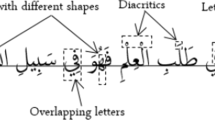Abstract
This work presents an embedded Arabic OCR system. The proposed system is compact and portable which make it useful for many applications such as blind assistance and language translation. OCR system consists of the sub-systems: image acquisition, pre-processing, segmentation, feature extraction, classification, and post- processing. For each sub-system there are several of algorithms and techniques to be implemented. Working with PCs gives the designer freedom to select the algorithms and techniques according to the required performance, reliability and reusability. However with the embedded systems we are facing many problems and challenges. Such challenges are associated with memory, speed, and computational power. FPGA is selected as the hardware platform for realizing that recognition task. An OCR system is designed and implemented on PC. Then this system is transferred to FPGA after a set of optimization procedures. Utilizing the features of FPGA technology, Hardware / Software co-design is accomplished on an FPGA board. In that design the systems is partitioned into software modules and hardware components to get the advantages of software flexibility and hardware speed. A database of 3000 Arabic characters is used to train and test the performance of the system. The effects of changing the number of features and classification parameters on accuracy, memory and speed are measured. Design points are selected in order to improve the memory required, speed and computation power without affecting the accuracy.







Similar content being viewed by others
References
R. K. Agrawal, Bala, R., & Bala, M. (2008). Discriminant function Revisited for Incremental Learning. Sixth Indian Conference on Computer Vision, Graphics & Image Processing. ICVGIP '08, pp: 435–441.
Amin, A. (2000). Recognition of printed Arabic text based on global features and decision tree learning techniques. Pattern Recognition, 33, 1309–1323.
Amin, A. (1997). Off line Arabic character recognition- a survey. Document Analysis and Recognition. Proceedings of the Fourth International Conference on Volume 2, Issue, 18–20 pp: 596–599 vol. 2.
Arica, N., & Yarman-Vural, F. T. (2001). An overview of character recognition focused on off-line handwriting. Systems, man, and cybernetics, part C: applications and reviews. IEEE Transactions, 31(2), 216–233.
Jain, A. K., Duin, R. P. W., & Mao, J. (2000). Statistical pattern recognition: a review. IEEE Trans. on Pattern Analysis and Machine Intelligence, 22, 4–37.
Altera Inc. (2006). Nios II processor reference handbook. Altera Corporation.
Broumandnia, A., & Shanbehzadeh, J. (2007). Fast Zernike wavelet moments for Farsi character recognition. Image and Vision Computing 25
Alnsour, A. J. (2006). Arabic handwritten characters recognized by neocognitron artificial neural network. University of Sharjah Journal of Pure & Applied Sciences Volume 3, No. 2.
Cheung, M. B. (2001). An Arabic optical character recognition system using recognition-based segmentation. Pattern Recognition, 34, 215–233.
Sackinger, E. (1996). VIP: an FPGA-based Processor for Image Processing and Neural Networks. Proceedings of Fifth International Conference on Volume, Issue, 12–14, pp: 330–336.
Valveny, E., Marti, E., & Edifici, O. (2001). Learning of structural descriptions of graphic symbols using deformable template matching. International Conference on Document Analysis and Recognition
Cloutier, J., & Cosatto, E. (1992). Application of the ANNA neural network chip to high-speed character recognition. IEEE TRANSACTIONS ON NEURAL NETWORKS, VOL. 3, NO. 3
Kavallieratou, E., Sgarbas, K. Fakotakis, N. & Kokkinakis, G. (2003). Handwritten word recognition based on structural characteristics and lexical support. Seventh International Conference on Document Analysis and Recognition, 2003. Proceedings. pp 562.
Kondo, T. (1988). Kanji character recognition unit with hand scanner using SIMD processor. SPIE Vol. 1001 Visual Communication and Image Processing.
Lorigo, L. M., & Govindaraju, V. (2006). Offline Arabic handwriting recognition: a survey. IEEE Transactions on Pattern Analysis and Machine Intelligence, 28(5), 712.
Sakai, M., Yoneda, M., & Hase, H. (1998). A new robust quadratic discriminant function. Fourteenth International Conference on Pattern Recognition, 1, 99.
Reyneri, L. M. (2004). A Simulink-based hybrid codesign tool for rapid prototyping of FPGA’s in signal processing systems. Microprocessors and Microsystems, 28, 273–289.
Haskell, R. E. (2001). FPGA integrated co-design. Proceedings of the International conference on microelectronics systems educations, IEEE.
Casey, R. G., & Lecolinet, E. (1995). Strategies in Character Segmentation: A Survey. Proceedings of the Third International Conference on Document Analysis and Recognition IEEE.
Hirano, T., Okada, Y., & Yoda, F. (1997). Structural character recognition using simulated annealing. Fourth International Conference on Document Analysis and Recognition, Aug 1997, Volume: pp 507.
Long, T., & Jin, L.-W. (2007). Building Compact MQDF classifier for off-line handwritten chinese characters by subspace distribution sharing. Ninth International Conference on Document Analysis and Recognition. ICDAR 2007. Volume 2 pp 909.
Author information
Authors and Affiliations
Corresponding author
Rights and permissions
About this article
Cite this article
Al-Marakeby, A., Kimura, F., Zaki, M. et al. Design of an Embedded Arabic Optical Character Recognition. J Sign Process Syst 70, 249–258 (2013). https://doi.org/10.1007/s11265-012-0662-x
Received:
Revised:
Accepted:
Published:
Issue Date:
DOI: https://doi.org/10.1007/s11265-012-0662-x




